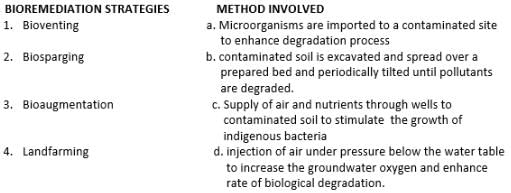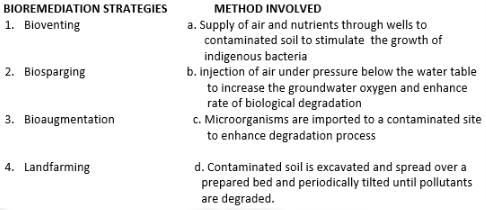UGC NET Environmental Science Mock - 1 - UGC NET MCQ
30 Questions MCQ Test UGC NET Mock Test Series - UGC NET Environmental Science Mock - 1
Arrange the following Lithospheric succession stages on a bare rock in ascending order.
1). Perennial stage
2). Moss stage
3). Lichen stage
4). Climax community
5). Annual stage
6). Shrub stage
Which of the following statements is/are correct about Biodiversity?
1). The degree of biodiversity increases with perturbation and heterogeneity.
2). Biodiversity increases when we move from low latitude to the high latitude.
In order to avoid catastrophic consequences of climate change, there is general agreement among the countries of the world to limit the rise in average surface temperature of earth compared to that of pre-industrial times by
Which of the following are correct about marine protected areas:
The transmission of receiver’s reaction back to the sender is known as?
A landfill is to be designed to serve a population of 200000 for a period of 25 years. The solid waste (SW) generation is 2 kg/person/day. The density of the un-compacted SW is 100 kg/m3 and a compaction ratio of 4 is suggested. The ratio of compacted fill (i.e. SW + cover) to compacted SW is 1.5. The landfill volume (in million m3) required is _______?
The CITES Secretariat is administered by which of the following organization?
A permeable rock that contains hydrocarbon fluids and gases is called a/an
Whcih of the following Biosphere reserve is not added to the UNESCO’s MAB programme?
Which of the following statements are correct regarding Gulf of Mannar Biosphere Reserve?
1. A famous pilgrim centre, Rameswaram, which finds place in the epic Ramayana is situated in the Gulf.
2. It was included in Man And Biosphere Programme of UNESCO in 2001.
Select the correct option from the codes given below:
Study of inter-relationship between organisms and their environment is
Consider the following statements about the Bio Toilet Project in Indian Railways:
- The bio-toilets are joint initiative of Indian Railways and DRDO
- The human excreta in the bio-toilets is treated through anaerobic digestion process
- The bio toilet reduces the solid human waste to biogas and pure water
Which of the above statements is/are correct?
Which of the following statements is correct about the Mammals of the tundra region?
- They have small body to minimise the loss of heat.
- They have small tail and small ear to avoid the loss of heat.
Select the correct option from the codes given below:
At what time during a 24-hour day would a radiation temperature inversion best be developed?
Which of the following type of pollution can cause the outbreak of jaundice
Which of the following is the study of the interactions among a collections of species that inhabit the same geographic area?
The amount of force exerted over an area of surface is called:
The lowest temperature is usually observed:
Write which is a long term pattern of weather at a particular area?
About which of the meteorologists and atmospheric scientists in the United States work in the field of weather forecasting?
Valuable, practical services that help to preserve ecosystem performed by nature are called
_________ is the most commonly used unit of radiation
Which of the following is/are most harmful to ozone depletion?
In an average year, more people die from this than from any other natural disaster.
|
92 docs|125 tests
|



















